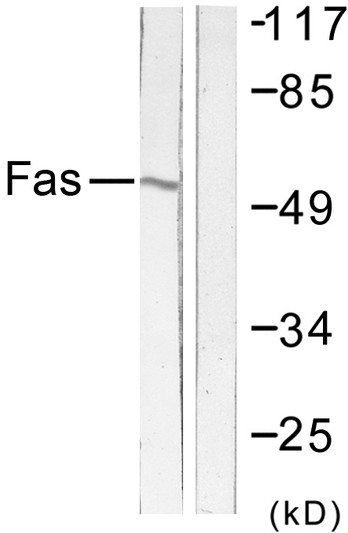| Post Translational Modifications | (Microbial infection) Glycosylated at Arg-250 by enteropathogenic E.coli protein NleB1: arginine GlcNAcylation prevents homotypic/heterotypic death domain interactions. Palmitoylated. Palmitoylation by ZDHHC7 prevents the lysosomal degradation of FAS regulating its expression at the plasma membrane. N- and O-glycosylated. O-glycosylated with core 1 or possibly core 8 glycans. |
| Function | Receptor for TNFSF6/FASLG. The adapter molecule FADD recruits caspase CASP8 to the activated receptor. The resulting death-inducing signaling complex (DISC) performs CASP8 proteolytic activation which initiates the subsequent cascade of caspases (aspartate-specific cysteine proteases) mediating apoptosis. FAS-mediated apoptosis may have a role in the induction of peripheral tolerance, in the antigen-stimulated suicide of mature T-cells, or both. The secreted isoforms 2 to 6 block apoptosis (in vitro). |
| Protein Name | Tumor Necrosis Factor Receptor Superfamily Member 6Apo-1 AntigenApoptosis-Mediating Surface Antigen FasFaslg ReceptorCd Antigen Cd95 |
| Database Links | Reactome: R-HSA-140534Reactome: R-HSA-3371378Reactome: R-HSA-5213460Reactome: R-HSA-5218900Reactome: R-HSA-6803211Reactome: R-HSA-69416Reactome: R-HSA-75157 |
| Cellular Localisation | Isoform 1: Cell MembraneSingle-Pass Type I Membrane ProteinMembrane RaftIsoform 2: SecretedIsoform 3: SecretedIsoform 4: SecretedIsoform 5: SecretedIsoform 6: Secreted |
| Alternative Antibody Names | Anti-Tumor Necrosis Factor Receptor Superfamily Member 6 antibodyAnti-Apo-1 Antigen antibodyAnti-Apoptosis-Mediating Surface Antigen Fas antibodyAnti-Faslg Receptor antibodyAnti-Cd Antigen Cd95 antibodyAnti-FAS antibodyAnti-APT1 antibodyAnti-FAS1 antibodyAnti-TNFRSF6 antibody |
Information sourced from Uniprot.org












